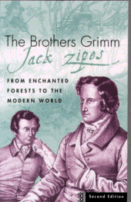The Brothers Grimm
St. Martin's Press, December, 2002.
Trade paperback, 384 pages.
ISBN: 0312293801
Ages 12 and up
 The leading authority on the fairy tale, Jack Zipes,
adds much new information to the legendary stories
about the Brothers Grimm, who are responsible for
creating most of the fairy tales that we all know and love.
With extensive research and meticulous
scholarship, Professor Zipes introduces the reader
to the social and historical milieu in which the Brothers
Grimm began both their life's work and also began the study
of folklore as we know it today. Their efforts were rewarded
with a popularity which has never waned. The brothers'
methods of telling the stories and of editing
the tales that they were told to make what we could consider
a "good" fairy tale have clearly stood the test of time. Fascinating chapters
follow the history of the impact of these tales on western thought and culture.
The leading authority on the fairy tale, Jack Zipes,
adds much new information to the legendary stories
about the Brothers Grimm, who are responsible for
creating most of the fairy tales that we all know and love.
With extensive research and meticulous
scholarship, Professor Zipes introduces the reader
to the social and historical milieu in which the Brothers
Grimm began both their life's work and also began the study
of folklore as we know it today. Their efforts were rewarded
with a popularity which has never waned. The brothers'
methods of telling the stories and of editing
the tales that they were told to make what we could consider
a "good" fairy tale have clearly stood the test of time. Fascinating chapters
follow the history of the impact of these tales on western thought and culture.
The surprising thing about the brothers Grimm is that they did not collect tales by going through the countryside and interviewing everyone's grandparents and ancient relatives, as was once thought. The stories came mostly from young middle class women and men in the Grimms' circle of acquaintances. To these were added tales taken down from several local storytellers. Other stories were taken directly from letters, journals and already published materials.
At this time in the infancy of the study of folklore and culture, the brothers met the needs of a growing but frustrated bourgeoisie who very much wanted to impart German culture to the minds of the young. Germans were separated into various principalities whose scions did not get along with there subject, nor with each other. That the Grimms made a great many changes while writing the tales is well known. How and why they made these changes was both due to the fact that the brothers were students of language and -- more importantly -- that some of the tales had to be cleaned up so that they could be read in a family setting with young children. They faced a real problem of finding variations in the plots of many of the tales. This problem also confronts the modern folklorist. Professor Zipes leads us through this process with several of the tales so that the reader can see how the changes were made.
The most interesting chapters in the book deal with how the fairy tale continues to influence the cultural psyche of the western world. The roles played by both women and men have entered into our literature and into our expectations of behavior. The didactic nature of the tales seeps into the minds of children from their earliest years and may continue for a lifetime with various consequences.
The Brothers Grimm, while scholarly in its scope, is also an enlightening reminder to both readers and writers of our debt to these two gentlemen who were instrumental in laying the foundation of modern folklore research. Reading this work will supply the reader and the writer with many reflections on the effect of fairy tales in our lives and in the lives of others.
--Sarah Reaves White
The Brothers Grimm is available for purchase on Amazon.com
Note: We may receive a commission from sales made through product links in this article.
This review was published in the April-May, 2003 of The Internet Writing Journal.
Copyright © Writers Write, Inc. All Rights Reserved.
